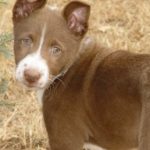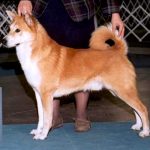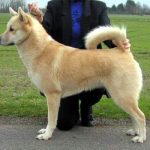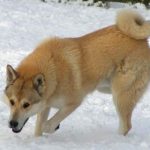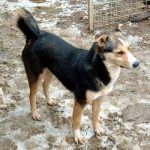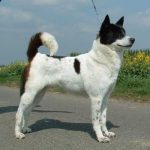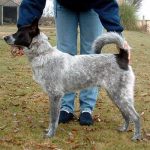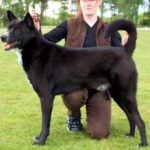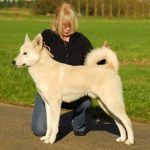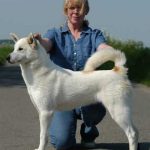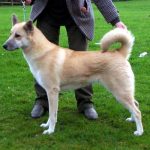Written by Jill Terry, this article first appeared in the British Canaan Dog Society’s newsletter, issue 2, December 2004.
Have you ever wondered how your dog came to be the colour he is? This article will hopefully explain just how colours are inherited and why there is such a wide range of colours in the Canaan Dog. If there is anything you don’t understand or isn’t quite clear, don’t be shy – contact us and we can delve further into the subject!
First though, we must look at just the very basics of genetics to understand some terms and how a dog inherits something. A gene is a submicroscopic particle that is the basic unit of heredity, but it’s far easier to imagine they are beads you can see and hold. The body has hundreds of beads (genes) that are attached to a long string, called a chromosome. Genes always occur in pairs, so picture a second string of beads to go with the first. Every dog has 78 chromosomes, or, more correctly, 39 pairs, each carrying hundreds of genes. Whilst scientists are still trying to find out where all the genes fit on the chromosome they do know that the place is always the same. The name of the place that they sit is known as the locus (plural being loci).
Each gene has variations that produce different characteristics; these variations are called alleles and are symbolised using a letter system, which we will soon see! While every gene has at least two alleles, some have more than two. However, no matter how many alleles (variations) a gene may have, a dog will only ever inherit two, one from each parent. The alleles of a pair can be the same (homozygous) or different (heterozygous). Now, unlike football, where the fastest or smartest sometimes wins, here the more dominant allele always wins and will be what you can see (phenotype). The other stays hidden and is carried as a recessive gene for the future.
As an example, let’s look at the gene for length of coat. The normal coat for a Canaan is represented by L (upper-case) and is dominant over a long-coat, represented by l (lower-case). So…
- LL will be normal coat and only pass on normal coat
- Ll will still be normal coat but could pass on long coat (L is dominant and therefore hides l)
- ll will be long coat and only pass on long coat
Sometimes you are not always sure what the second allele is, and in these cases when writing down the genes you put a _ for the one you don’t know.
Examples:
Layla Me Shaar Hagai is Ll, how do we know? Well she has a normal coat (L) but she has produced a long-coat (l) and in order for that to happen BOTH parents MUST be carrying for it.
Her daughter, Babrees The Cosmic Spirit, is L_ , why? She has a normal coat (L) but we do not know for sure which gene she inherited from her mother, it could be L or l. Whilst she has had a litter and not produced a long-coat, 6 puppies is not enough to be sure that she is definitely not carrying for long coat.
Now, just to complicate things a little more! Some genes interact with others and this can change the way they act! Bear this in mind and we will see how it works further on.
OK, hopefully you’re all still with me! So now we’ve got that out of the way, we’ll go on to discuss the genetics of colour.
The B Locus
This is a very simple gene with just two alleles and dictates the colour of the pigment in the nose, mouth and eye rims, as well as the coat. Liver (bb) is deemed as undesirable in the KC breed standard.
B – black. This produces black noses. Being the dominant allele on this gene, a dog with a black nose can be either BB or Bb. Therefore if put to either a liver dog or another black dog that is also carrying liver (b) they can produce liver puppies.
b – liver. Anything that would normally be black will be turned brown! So noses and pigment of liver dogs are brown, and if the dog’s coat is “genetically black” (see K locus below) that will also appear as brown. Being recessive to B any dog showing a brown nose is definitely bb (homozygous) and when bred to another liver dog cannot produce puppies with black pigmentation. The eye colour of a liver tends to be lighter.
Examples:
- BB – black pigment and can not produce liver
- Bb – black pigment but carries liver
- bb – brown (liver) pigment and can not produce black
The following photos show a 3-month old liver puppy, courtesy of Chris Miller.

The Agouti Locus (A)
There are four alleles (variations) at this locus, in order of dominance they are:
ay – Sable. This colour is a basic red background with a black overlay. When sable Canaan Dogs are born the black overlay makes them look very dark, in some cases they look black because they are so dark. With age the black hairs fade leaving the coat red, which can lighten so you end up with dogs of various shades from pale sand to a deep rich red. Sometimes the black hairs remain visible, but this is not desirable in Canaan Dogs.
The following dogs are all genetically sable and show the varying shades. The first two are not solid colours but they have patches of sable on a white background.
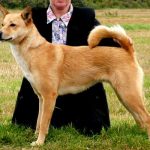
at – Black and Tan. This produces what is known as a tan-point pattern, which means the dog will be black with areas of tan pigment on the sides of the muzzle, throat, belly, inside the ears, on the chest, over each eye, on all four feet and part of the legs, around the anus and the underside of the tail. The extent of the tan varies and may show in either just one or two of these points or all of them, or could extend beyond them. The depth of pigment also varies and may be as a deep rich tan colour or a very pale cream.
When modified by the gene for white (see the spotting (S) locus below) it will produce a tri-colour.
The tan colour is not usually seen at birth, the puppy appearing black with white — the tan appearing later. Prof. Menzel decreed this colour to be undesirable as she believed it to be “untypical of the breed”. Israel, together with the rest of Europe, neither breed from nor show dogs of this colour. The colour is also listed as undesirable within the UK breed standard, however, dogs of this colouring have been shown and bred from in the UK.
The following dogs are all black and tan (the last two modified by white and therefore are really tri-colour)
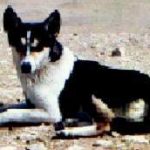
aw – Wild agouti. This colour is the banded grey that is found on the Keeshond and also the wolf. Menzel deemed this to be undesirable and it was believed to be indicative of impure blood (not true Canaan).
The wolf in the photo to the right shows this colouring.
a – Recessive Black. There are very few breeds that actually carry recessive black, the Canaan Dog is not believed to be one of them, so we can forget about this allele!
The K Locus (K)
K (upper-case) – This produces a black coat and is dominant to the agouti locus. This means that no matter what a dog may have at the agouti locus, a dominant black (K_) will over-ride it and the dog will be black. So a dog whose phenotype (look) is a red must be kk (not carrying black) at this locus, subsequently two dogs that are true sable red mated together can not produce black.
The following dogs are all black. The first two dogs are obviously black and white, this is still caused by the K allele but modified by the spotting locus which we will discuss further on, as are the dogs with white trim.
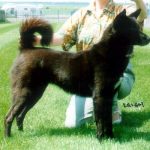
k (lower-case) – this allele is recessive, allowing whatever is at the agouti locus (ie red or black and tan) to be seen.
kbr – Brindle. Brindle produces a pattern of black stripes. Until recently, when it was proven otherwise, it was believed that brindle came from the Extension locus, now it is believed to be a recessive under the K locus. Menzel deemed this colour to be undesirable and believed it to be indicative of impure blood.
The Spotting Locus (S)
This gene is not a colour gene but it produces the pattern of the coat by controlling the distribution of white. There are four alleles to this gene, and each one has modifying factors – plus to allow more colour and minus to restrict it. These modifiers mean that it can be difficult at times to tell the difference between the alleles, what you may think is Irish Spotting is actually self-colour but with minus modifiers!
S – self-colour with no white. This is usually the solid coloured dog. However, because of the modifiers it is possible for this allele to also express minor white markings – white toes, white tail tip, or a star or streak on the chest. At their extreme these can be similar to minimal Irish spotting markings. The following photos show dogs that are S_

si – Irish spotting. This produces a pattern of white on the muzzle, a star or blaze on the forehead, chest, belly, feet and tip of tail. A good example of this can be seen with the Basenji. The white can be minimal and on just one of those locations, or it can be extended to be on all of them, even extending further producing a collar (or part collar) and possibly causing the white areas to merge together. These markings are obviously more visible on black and darker colours than the lighter coloured dogs.
The following dogs appear to have Irish Spotting.
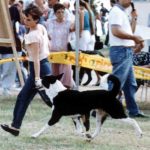
The Black and white dog on the right could more than likely be Irish Spotting, however, he could just be a spotting with minus modifier!
sp– piebald spotting. This allows large patches of colour to be expressed, often called piebald or harlequin. With extreme minus modifiers this can be similar to extended Irish spotting, while extreme plus modifiers could overlap with the plus modifiers extreme white.
The photo on the left shows a dog that is piebald.
sw – Extreme White. This depicts a dog of white colour but beware! The dog could have plus modifiers which will give a splash of colour. Also, in the majority of breeds today a “white” coat can be caused by ee (see the extension locus below). Dalmatians are one breed where the white is due to this allele. They are born pure white, their spots (caused by ticking) come later. A white dog that looks off-white, yellowy/white or patchy in certain lights is white due to the ee allele, not extreme white. Unfortunately, extreme white has been shown to be connected to deafness. The photo on the right is of an extreme white Canaan Dog that also has a few red patches.
The Ticking Locus (T)
Again, not a colour but a pattern. This pattern produces flecking, or ticking, that can be seen on white areas of the coat.
T (upper-case) – ticking. This produces those spots or flecks of colour that you often see in the white areas of a dog. This locus has only two alleles which act like a light switch – dominant is on and recessive is off. The pattern is not there when the puppy is born, but develops later. There can be just a few spots on the white that you may not be able to see in the photo, or so many that they practically merge into each other.
The following dogs all have ticking to a greater or lesser extent.

t (lower-case) – no ticking. This allows the white on a dog to be just pure white, with no flecks of colour. I have no photos of Canaan Dogs with absolutely no ticking! Of course you cannot tell with dogs that have no large patches of white and it doesn’t always show up on light coloured dogs in a photo.
Em – Mask. This produces a black mask in a characteristic pattern on the muzzle, which may extend up onto the ears and even further. However, this allele is not responsible for the symmetrical head markings seen on some black and white or red and white dogs, which is caused by the spotting allele as above. The effect of Em is apparent on sand or red dogs that are genetically sable (ay_, Em_), but of course would not be visible at all on a black dog (K_, Em_). If a black and tan (atat) dog carries Em then the tan points on the head will not be visible. In Canaan Dogs the mask often fades as the dog matures, to the point that it is can hardly be seen in an adult.
The Canaan Dog on the left has a small mask.
The following do NOT have masks in genetic terms, their head & face markings are due to the Spotting locus.

E – allows dark pigment. This means that any black hairs the dog may have on his coat will be visible.
The following are all E_. The black ones are obvious because if they were ee they would not be black but cream! We know the others are not ee because when they were born their red/cream coat had a black overlay. Again, with ee this would not have been possible. They should all have good dark pigment, and will not suffer from “snow nose” (fades to pink in winter).

e – restricts dark pigment. OK, this might be confusing because this allele washes away all black hairs and what could effectively be a genetically black dog can look cream or red. The first photo below is an excellent example. We believe this dog to actually be black and white but he is ee so you can’t see the black, it’s hidden! This is the only time that a dog that looks red or cream can actually produce a black puppy when mated to a light coloured (not black) dog because and it means that they are genetically black but the black hairs are washed by the ee. This gene only affects black pigment, not yellow/red. It also affects the nose pigment, giving the dog what is termed a snow (fades to pink in winter) or dudley (fades to pink all year round) nose. The cream Canaans in the UK, and some of the red ones too, all appear to be ee, and is the reason why many dogs currently have poor nose pigment during the winter.
The following dogs are all ee.
I hope that this has all made sense for you and you are just a bit wiser as to how your Canaan Dog gets his colour!

